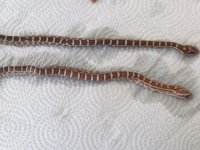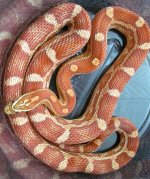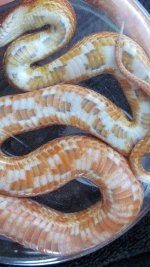Here's a clutch that hatched recently: 10 oddballs (plus 2 DIE) that all show significant color and pattern aberrancy. 4 are amels, but until they shed, it's easier to see on the "normals." (These pics are prior to first shed.)
I don't even know what pheno to label the parents, given their own oddities of coloration, but they are both het amel and motley or stripe. Both have bronzed belly checkers, making me suspect hypo, and the male is colored like a Buf, while his sister is redder, but still an odd color.
I was testing the father for Buf, and got 2-3 Buf-like colorations. The rest are all too red for Bufs, but seem to have an unusual degree of yellow. They're also very light for normals, as are the parents . . . making me wonder about hypo (which neither grandma or grandpa were known to carry).
The patterns are divisible into two groups: the "normals" (like the two DIEs pictured), which have normal belly checks, and the "motleys," which have solid black bellies or bellies fading to black at the edges (kind of hard to describe).
I also like the white "eyebrows" some have.
I'd love to hear thoughts!
Catherine
I don't even know what pheno to label the parents, given their own oddities of coloration, but they are both het amel and motley or stripe. Both have bronzed belly checkers, making me suspect hypo, and the male is colored like a Buf, while his sister is redder, but still an odd color.
I was testing the father for Buf, and got 2-3 Buf-like colorations. The rest are all too red for Bufs, but seem to have an unusual degree of yellow. They're also very light for normals, as are the parents . . . making me wonder about hypo (which neither grandma or grandpa were known to carry).
The patterns are divisible into two groups: the "normals" (like the two DIEs pictured), which have normal belly checks, and the "motleys," which have solid black bellies or bellies fading to black at the edges (kind of hard to describe).
I also like the white "eyebrows" some have.
I'd love to hear thoughts!
Catherine
Attachments
Last edited:













